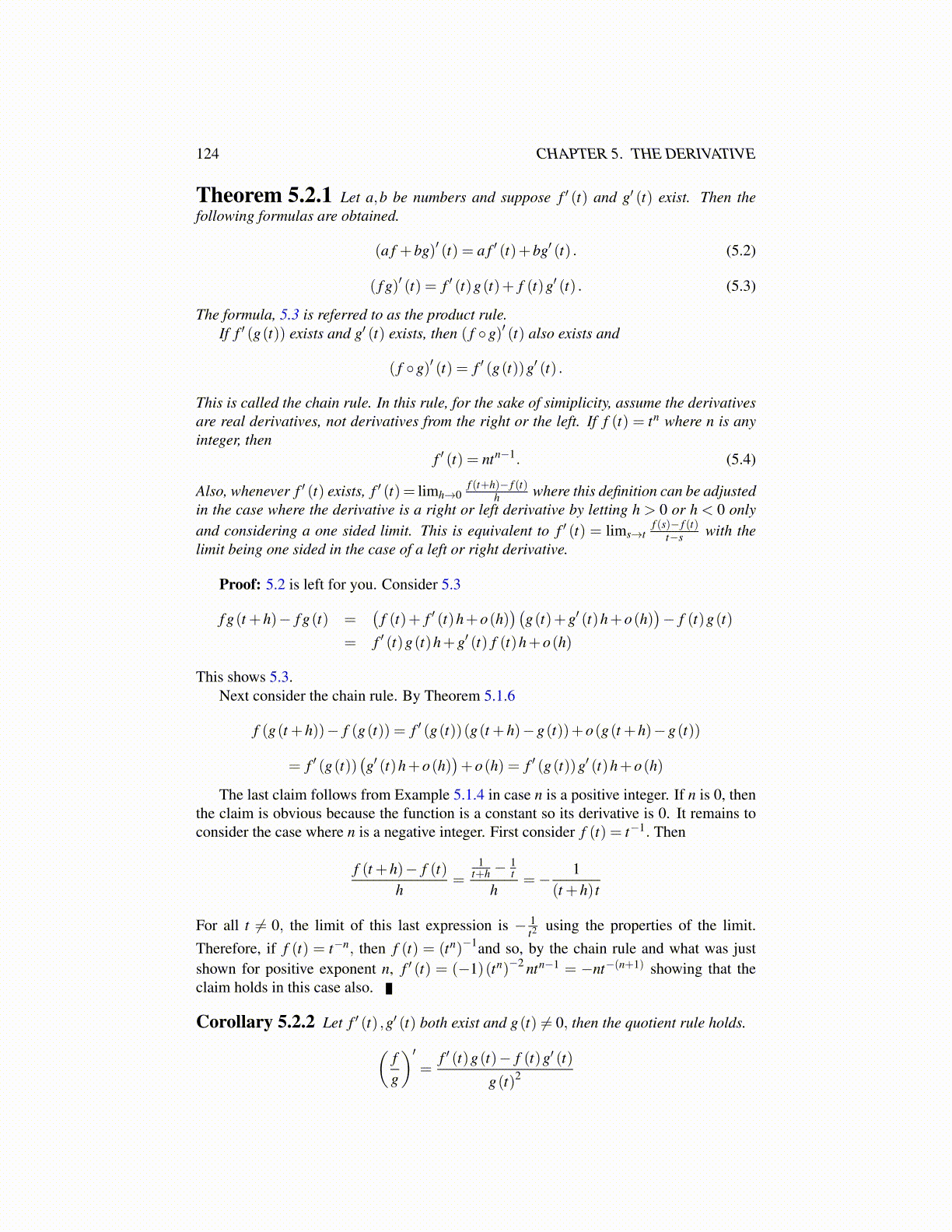
124 CHAPTER 5. THE DERIVATIVE
Theorem 5.2.1 Let a,b be numbers and suppose f ′ (t) and g′ (t) exist. Then thefollowing formulas are obtained.
(a f +bg)′ (t) = a f ′ (t)+bg′ (t) . (5.2)
( f g)′ (t) = f ′ (t)g(t)+ f (t)g′ (t) . (5.3)
The formula, 5.3 is referred to as the product rule.If f ′ (g(t)) exists and g′ (t) exists, then ( f ◦g)′ (t) also exists and
( f ◦g)′ (t) = f ′ (g(t))g′ (t) .
This is called the chain rule. In this rule, for the sake of simiplicity, assume the derivativesare real derivatives, not derivatives from the right or the left. If f (t) = tn where n is anyinteger, then
f ′ (t) = ntn−1. (5.4)
Also, whenever f ′ (t) exists, f ′ (t)= limh→0f (t+h)− f (t)
h where this definition can be adjustedin the case where the derivative is a right or left derivative by letting h > 0 or h < 0 onlyand considering a one sided limit. This is equivalent to f ′ (t) = lims→t
f (s)− f (t)t−s with the
limit being one sided in the case of a left or right derivative.
Proof: 5.2 is left for you. Consider 5.3
f g(t +h)− f g(t) =(
f (t)+ f ′ (t)h+o(h))(
g(t)+g′ (t)h+o(h))− f (t)g(t)
= f ′ (t)g(t)h+g′ (t) f (t)h+o(h)
This shows 5.3.Next consider the chain rule. By Theorem 5.1.6
f (g(t +h))− f (g(t)) = f ′ (g(t))(g(t +h)−g(t))+o(g(t +h)−g(t))
= f ′ (g(t))(g′ (t)h+o(h)
)+o(h) = f ′ (g(t))g′ (t)h+o(h)
The last claim follows from Example 5.1.4 in case n is a positive integer. If n is 0, thenthe claim is obvious because the function is a constant so its derivative is 0. It remains toconsider the case where n is a negative integer. First consider f (t) = t−1. Then
f (t +h)− f (t)h
=1
t+h −1t
h=− 1
(t +h) t
For all t ̸= 0, the limit of this last expression is − 1t2 using the properties of the limit.
Therefore, if f (t) = t−n, then f (t) = (tn)−1and so, by the chain rule and what was justshown for positive exponent n, f ′ (t) = (−1)(tn)−2 ntn−1 = −nt−(n+1) showing that theclaim holds in this case also.
Corollary 5.2.2 Let f ′ (t) ,g′ (t) both exist and g(t) ̸= 0, then the quotient rule holds.(fg
)′=
f ′ (t)g(t)− f (t)g′ (t)
g(t)2